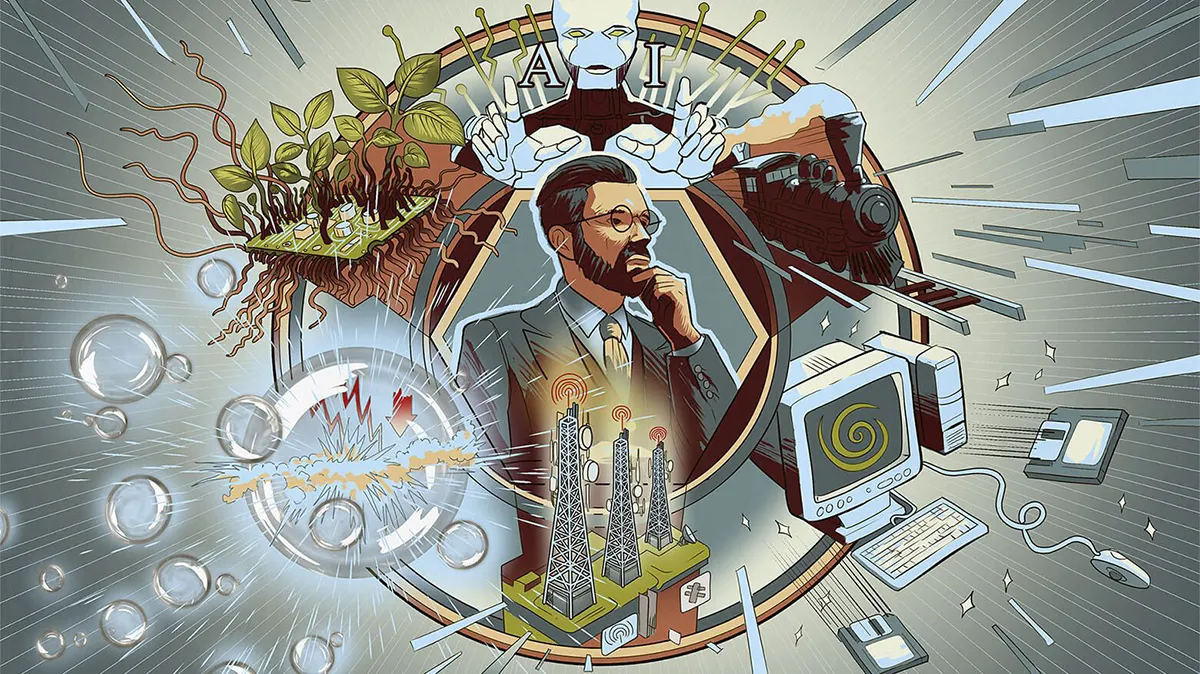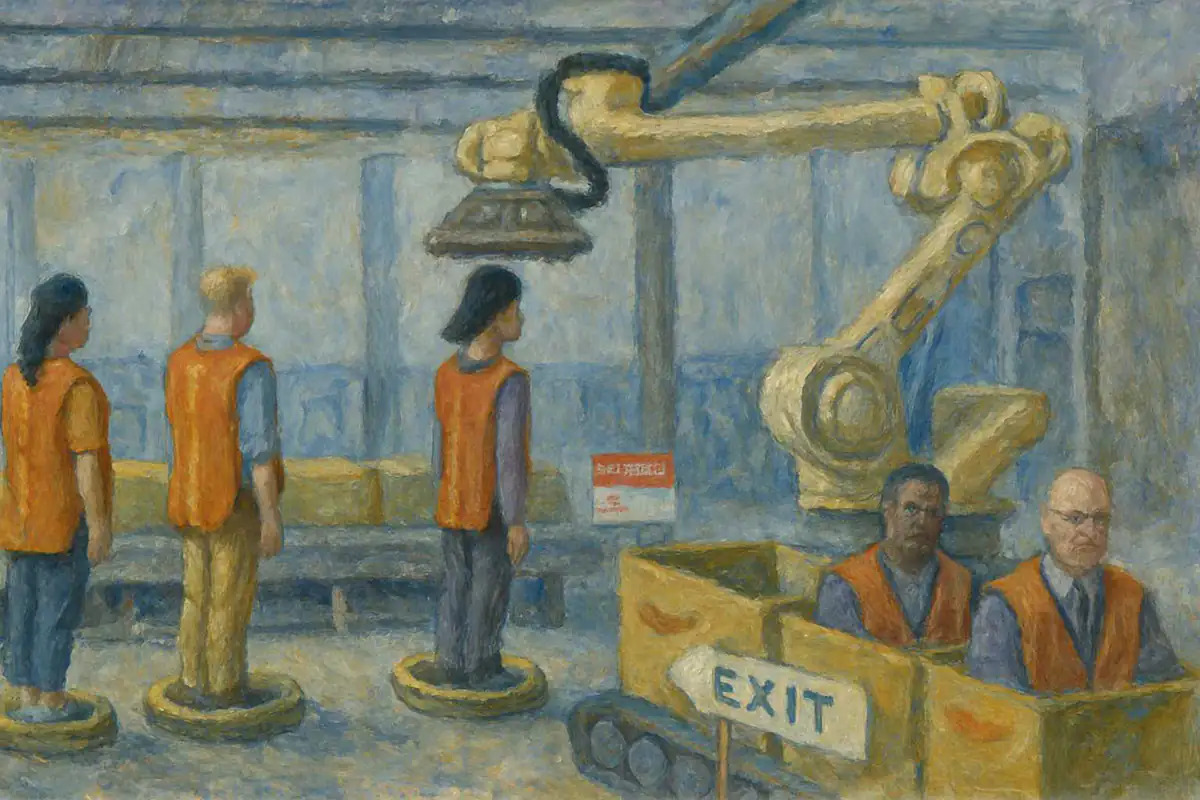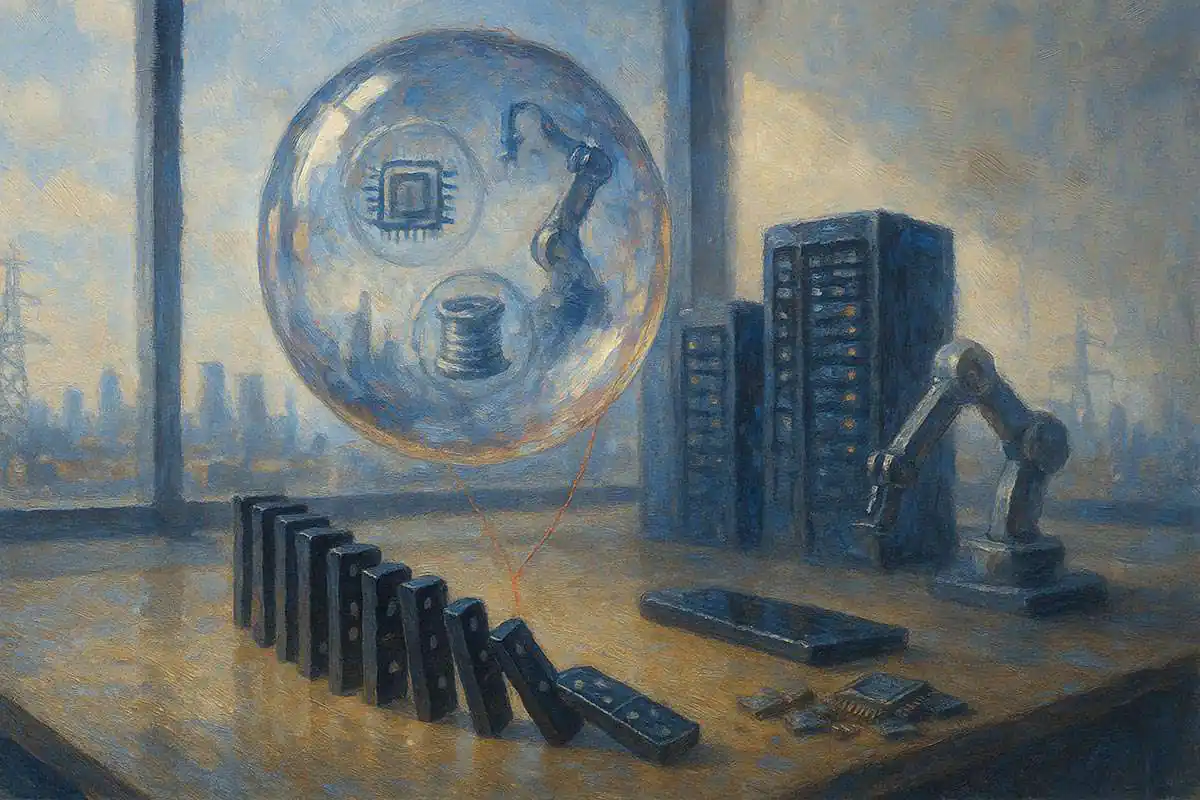AI has a feel of “this time is different.” Optimism rarely erupts about the same technology twice; this is why history doesn’t repeat but rhymes. The technology at the core of the mania is different every time. What doesn’t change over time is human emotion – the fear of missing out and then the fear of loss, in that order.
Humans are an optimistic bunch. We need it; it’s essential to our survival and progress; but eventually, we take our optimism too far. The graveyard of financial ruins is full of these stories.
I have beat the dotcoms and Nifty Fifties to death, so let’s go to back another century. My friend the brilliant Edward Chancellor wrote about the railroad boom and bust in England in the 1800s. Here he is, edited for brevity:
The first railway to use steam locomotives opened in 1825 and was designed to carry coal, not passengers. Railway promoters simply did not appreciate the potential demand for high-speed travel. The successful launch of the Liverpool and Manchester Railway in 1830, however, demonstrated the commercial viability of passenger travel. By the early 1840s, Britain’s railway network stretched to more than 2,000 miles. Railway companies were delivering acceptable, if not spectacular, returns for investors.
Then railway fever suddenly gripped the nation. Enthusiasts touted rail transport not just for its economic benefits, but for its benign effects on human civilization. One journal envisaged a day when the “whole world will have become one great family speaking one language, governed in unity by like laws, and adoring one God.” In the two years after 1843, the index of rail stocks doubled.
Investment peaked at around 7% of Britain’s national income. Railway enthusiasts predicted that rail would soon replace all the country’s roads and that “horse and foot transit shall be nearly extinct.”
In 1845, Britain’s railways carried nearly 34 million passengers. If the 8,000 miles of newly authorized railways were to deliver their expected 10% return, then the industry’s total revenue and passenger traffic would have to climb fivefold or more – all within the space of just five years. “This should have alarmed observers by itself… But they were deluded by the collective psychology of the Mania”, writes Odlyzko.
In 1847 a severe financial crisis broke out, induced in part by the diversion of large amounts of capital into unprofitable railway schemes. It turned out that the revenue projections provided by so-called “traffic takers” were wildly overoptimistic. Railway engineers underestimated costs. The vogue for constructing direct lines between large urban centers proved mistaken, as most traffic turned out to be local. As a result, Britain’s rail network was plagued with overcapacity. By the end of the decade, the index of railway stocks was down 65% from its 1845 peak.
The railroad bubble in England is just one example; there are hundreds of similar stories across market history. They all share this theme:
A new technology appears on the horizon. In the early stages, investment is rational, but then at some point excitement, imagination, and optimism take over, leading to overinvestment (usually creating a financial bubble). Investors make a lot of money until most lose it all. When the dust settles, only a few companies survive.
This AI boom reminds me of the telecom sector in the 1990s. The internet was going to change the world, and it did, but first we had tremendous overcapacity in global fiber and telecom equipment.
One could say that telecommunications companies overestimated demand for broadband and underestimated changes in technology, and that would be true. But there was a more nuanced dynamic at play, what economists call the fallacy of composition: What’s true for one participant isn’t necessarily true for the group.
Here’s a quick example: If you’re at a football game and you stand up, you’ll see better. But if everyone stands up, nobody sees any better. In the telecom industry, optimism led to collective action by hundreds of participants who poured hundreds of billions of dollars into fiber and infrastructure investment, ultimately killing the economics of the business.
What made this situation even more complex was the institutional imperative. It would have been difficult for the CEOs of these companies to opt out of making these investments and still keep their jobs. Shareholders would have likely revolted and fired them.
New technological advancements are built on the backs of optimistic equity investors (your neighbor) and piles of debt. Billions of dollars of malinvestment, hundreds of billions in market value wipeout, a few large bankruptcies, and we ended up with an incredible global telecommunications network. These companies are mostly forgotten and not there to remind us of their short-lived glory. Most investors today don’t remember magnificent companies in the telecommunications space that were going to change the world and had to be owned at any price: Nortel, JDS Uniphase, Ciena, Level 3 Communications, Qwest Communications – the list is long.
Something similar is happening in AI investments today. Look at the spending and the scale at which each company is investing in AI – they believe they cannot not make these investments. The total bill will be in the hundreds of billions.
Unlike telecom companies of the 1990s, the Magnificent 7 have highly cash-flow-generative businesses, so I’m not predicting they’ll go bankrupt. But it’s very likely that they have collectively overinvested in AI, and the returns on this investment will be very disappointing.
Also, though it’s hard to imagine today, it’s very likely that five to ten years from now, their magnificence will have faded. Ego, new competition, almost unavoidable malinvestment, and poor stock performance and thus diminished employee morale are usually responsible for that. There will be new, no less magnificent companies, and new bubbles. And hopefully this marathon runner will still be writing about why he doesn’t run sprints.
In the meantime, we’re going to play games we think we understand and can win in the long term (though we can’t make any promises). Our goal isn’t to bring “excitement” to your portfolio, and what we own is going to make for a boring conversation with your neighbor who has a hot hand right now.
Hopefully, this boredom will pay off. Your neighbor, after losing a good chunk of his net worth, will hire someone like us to manage his shrunken and less magnificent nest egg and will probably be embarrassed to talk to you about his portfolio and instead switch to sports and politics.
I have a very selfish interest in being rational and process-driven – my family’s entire liquid net worth is invested right alongside yours. I don’t have any other outside investments. I’m in the same boat as you, eating the same soup I’m serving you.
Being thoughtful, rational, and process-driven is just another day at IMA – it’s in our DNA. We don’t play the games that are exciting and even rewarding in the short term but are destined to fail when the dust settles.
On a personal note, I have to thank Michael Conn, IMA’s cofounder, for building a foundational layer of IMA DNA and the impact he had on me. Mike is definitely a visionary. He hired me on August 31, 1997, when I had been in the US for only six years. This was years before I received a graduate degree in finance and my CFA, before I taught investments at university, before I wrote books. My English was horrible, and I was in my last semester completing my undergraduate degree in finance at CU Denver. He saw more in me than I saw in myself.
The US stock market was in the very early stages of the dotcom bubble, and the next three years were treacherous. I remember countless meetings with clients who were upset with Mike for not playing the game of dotcoms and tech stocks that everyone “had to own”. The IMA portfolio was doing fine, but it lacked the excitement and high-octane returns that the new world had offered. Mike patiently explained that we owned a lot of high-quality, undervalued companies. Though he didn’t know when this mania would end, he knew that it would, bringing a lot of tears to those who had been uncorking champagne.
Some clients appreciated his insights, some did not and cancelled their accounts and found managers who would “perform.” Mike was unfazed by cancellations and stuck to what made sense. He was willing to lose clients but not their money; he had soul in the game.
There’s a quote often attributed to Albert Einstein: “Insanity is doing the same thing over and over again and expecting different results.” As an investor, especially if you manage someone else’s capital, you have to be slightly insane. During market manias, time slows down to dog years. You have to keep doing the same (rational) thing but expect a different outcome, knowing that at some point it will come.
Watching Mike being unafraid of being rational – contrarian, if you like – when the world was going bananas over the latest craze, instilled this contrarian gene in me.
Key takeaways
- Technology-driven market manias follow a recurring pattern: rational early investment gives way to overoptimism, leading to overinvestment and bubbles, with only a few survivors emerging post-burst.
- The current AI boom echoes past technology bubbles, like the 1990s telecom boom, where collective overinvestment led to overcapacity and economic challenges.
- Even cash-rich tech giants (Magnificent 7) may be collectively overinvesting in AI, potentially leading to disappointing returns and faded “magnificence” in the future.
- Rational, process-driven investing may seem boring during technology-fueled market frenzies, but it’s crucial for long-term financial health and avoiding the pitfalls of short-term excitement.
- Maintaining a contrarian stance during technology bubbles requires a degree of “insanity” – consistently applying rational principles even when the market temporarily rewards irrational behavior.









Hi Vitaliy, I am a UK based retired independent financial adviser and I am a massive fan of every aspect of your approach – your father and brother’s paintings, your essays on classical music and above all your common sense approach to value investing. I was a very early purchaser of your excellent book “Soul in the Game” which I have read several times. I had already read the classic “Meditations” by Marcus Aurelius and your chapters on stoic philosophy served as an excellent reminder of the salient teachings in that book.
We exchanged emails some long time ago and you indicated that my being based in the UK is not an impediment to becoming one of your clients but perhaps I didn’t make it clear that my and my wife’s share based investments are all held within UK tax-free wrappers – pensions and ISAs. How would you be able to take over the management without us losing the preferential tax treatment? I will be 70 in December and my wife is only 61. We are both in good health, can take a reasonably long term view and do not take any income from our investments although that may change when my wife retires in possibly 2 years’ time.
I would also add that I believe your approach could have significant appeal to other UK investors if the tax problem could be overcome! Having said that, we have a financial regulator in the UK whose rules could make any professional investment manager lose the will to live!
Keep up your excellent work Vitaliy, I look forward to your musings and read every one of them.
Ai is different. From an earnings perspective its mostly about the magnificent 7 getting relative market share from each other.
But smaller companies will need AI to replace staff at call centers and it will gut middle management.
From a labor perspective, its all about replacing human labor, not just muscle, but also decision making.
Its timely too, coming as demographics turn up the ratio of pension aged people to active workers and as the west is trying to decouple itself from
made in China.
On the cost side there is a huge energy cost , to build the chips and to run them.
On the risk side, AI is still software, and there are infinite ways to make bad software.
the profits in AI will be most noticeable, not where it does stuff a little better than a person, but where it opens up whole no economic activities that weren’t viable.
In the end if AI leads to more optimized energy and construction and transport it is a powerful net enhancement of productivity,
so put me in the “this time is different”
Hi, Vitaliy:
I particularly appreciated the fallacy of composition example of spectators standing up at game. I formerly thought of it more in the harder sciences, such as molecules like water, not having the same properties of the constituent elements, hydrogen and oxygen.
However, since you deal with economics (among other things), the example I think of is offering discounts on products. Eventually, all marketers/ vendors feel compelled to do the same. So now, a buyer has to collect coupons (for the discounts) and whatever else is required just to break even with everybody else.
In other words, what started out as a sales gimmick with brief savings for a few, quickly devolves into a requirement – just to not lose out. In particular, I also think of those decades ago when one of the car companies decided to give cash back. Soon all the competitors had to do it just to keep even. They all or almost seem to advertise this still, but that could be selective perception on my part. The point is that this practice has not died out. (Am I wrong?)
In my own life, for a very long time, I realized that finding a place (e.g., supermarket or restaurant) with better quality product and yet very highly competitive pricing would never and could never be permanent. I say that because, as the reward for doing so was noticed by the seller, that would allow him to increase prices to match the new demand.
Thus, unless there are other countervailing factors, an equilibrium pushes this all back into place.
One more example: In driving, upon seeing a lane “open up” on a highway, one may gain a slight advantage for perhaps a minute by switching, but equilibrium once again will apply and the advantage disappears.
Does my understanding agree and coincide with your thoughts? Somehow, although clearly related examples, I seem to have gotten off the fallacy of composition with what I cited…
(Dr. Mike Ecker is a PhD mathematician, a retired Penn State U. math professor, the problem section editor of the mathematics journal MAE, and a computer collector with a possible world record number.)
Another great letter. So sorry that we couldn’t get together, but look forward to meeting in the flesh soon.
GREAT letter! So many things I could share with my own experiences in this industry since 1995.
As a Mutual Fund Wholesaler in the late 90’s I used to use a prop (that I still have today).
I would hand an audience member a typed word document and ask them to read it.
It read:
“To the question, what went wrong in the stock market?…
It was such a vast bull market, rising so spectacularly, that anybody with eyes was bound to see it, and anybody with a normal quota of human greed was bound to hanker to climb abord…
People turned to the new issues traded over the counter. New companies with untried management, small earnings and dubious prospects – with nothing more but a prayer and a catchy space aged name – were bid up as much as 400% within a few months. As long as investment psychology was so optimistic, nothing seemed able to stop the market…
By the end, when the Dow Jones Index hit an all-time high, stenographers, barbers, and schoolteachers were scanning the market pages and counting their profits…”
Again, I was using this in 2000 and 2001…
Most in the audience didn’t catch the subtle hints of when this article was published. Some might have caught the mention of “stenographers” or “market pages” as a clue. I would ask the audience when they thought that article was published. Most would say this was a recent publication. Something they might have just read pertaining to the recent market experience. After a bit of a pause, I’d slide out of a sleeve my copy of Life magazine from June 8th, 1962! Jaws would drop. As you are probably aware physical Life magazines back then were significantly larger. The size of the magazine and the pictures on the cover and inside that article ALWAYS got the reaction I was looking for.